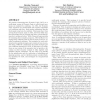302 search results - page 37 / 61 » Deriving input syntactic structure from execution |
ICCD
2005
IEEE
14 years 6 months ago
2005
IEEE
Traditional approaches for sequential logic optimization include (1) explicit state-based techniques such as state minimization, (2) structural techniques such as retiming, and (3...
ISCA
2012
IEEE
12 years 9 days ago
2012
IEEE
Soft error reliability has become a first-order design criterion for modern microprocessors. Architectural Vulnerability Factor (AVF) modeling is often used to capture the probab...
TON
2010
13 years 4 months ago
2010
This paper presents "Self-Chord," a peer-to-peer (P2P) system that inherits the ability of Chord-like structured systems for the construction and maintenance of an overla...
ATAL
2010
Springer
13 years 11 months ago
2010
Springer
We propose Alternating-time Dynamic Logic (ADL) as a multi-agent variant of Dynamic Logic in which atomic programs are replaced by coalitions. In ADL, the Dynamic Logic operators ...
COLING
1996
13 years 11 months ago
1996
We describe a bidirectional framework for natural language parsing and generation, using a typedfeatureformalismand an HPSG-based grammar with a parser and generator derived from ...

